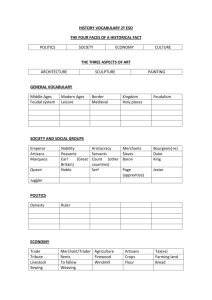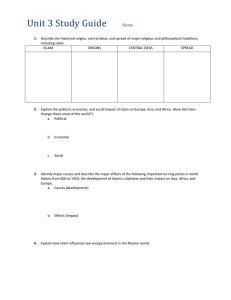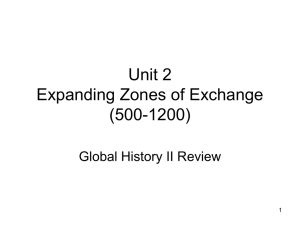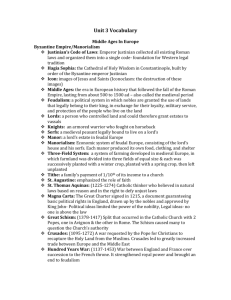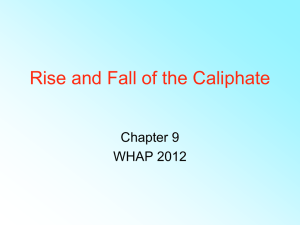Semester Exam Review Key Unit 3
advertisement
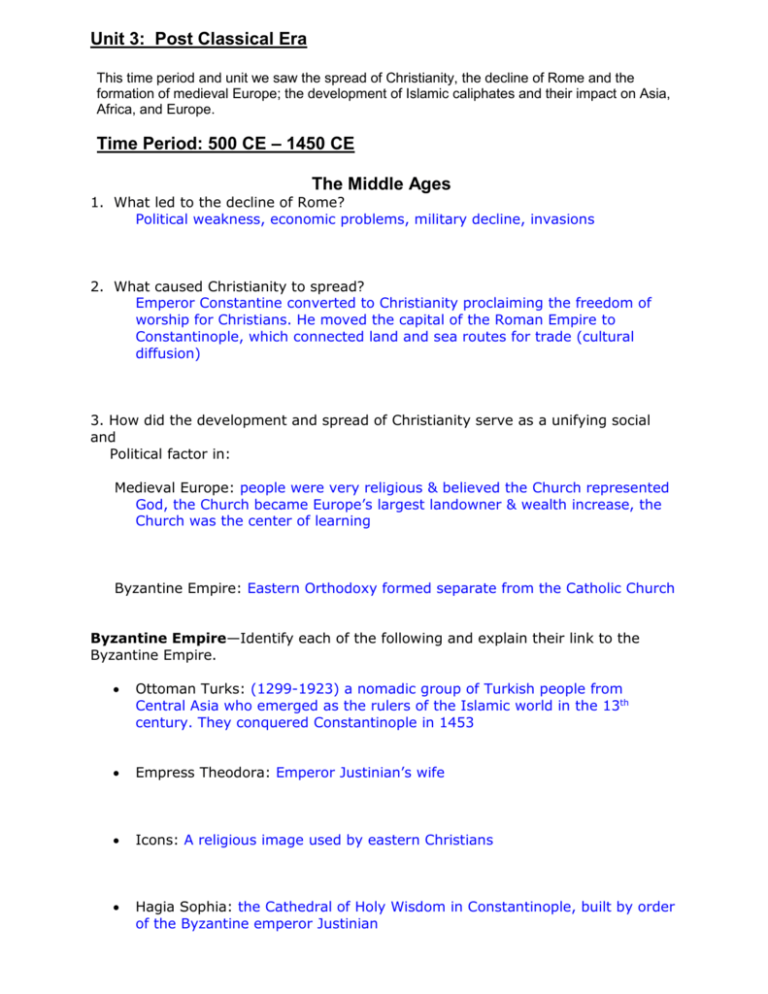
Unit 3: Post Classical Era This time period and unit we saw the spread of Christianity, the decline of Rome and the formation of medieval Europe; the development of Islamic caliphates and their impact on Asia, Africa, and Europe. Time Period: 500 CE – 1450 CE The Middle Ages 1. What led to the decline of Rome? Political weakness, economic problems, military decline, invasions 2. What caused Christianity to spread? Emperor Constantine converted to Christianity proclaiming the freedom of worship for Christians. He moved the capital of the Roman Empire to Constantinople, which connected land and sea routes for trade (cultural diffusion) 3. How did the development and spread of Christianity serve as a unifying social and Political factor in: Medieval Europe: people were very religious & believed the Church represented God, the Church became Europe’s largest landowner & wealth increase, the Church was the center of learning Byzantine Empire: Eastern Orthodoxy formed separate from the Catholic Church Byzantine Empire—Identify each of the following and explain their link to the Byzantine Empire. Ottoman Turks: (1299-1923) a nomadic group of Turkish people from Central Asia who emerged as the rulers of the Islamic world in the 13th century. They conquered Constantinople in 1453 Empress Theodora: Emperor Justinian’s wife Icons: A religious image used by eastern Christians Hagia Sophia: the Cathedral of Holy Wisdom in Constantinople, built by order of the Byzantine emperor Justinian 4. What were the political and legal ideas contained in the Code of Justinian? Collected all existing Roman laws and organized them into a single code which served as guide on most legal questions (ex: an eye for an eye) 5. Explain the characteristics of Roman Catholicism and Eastern Orthodoxy by completing the chart below: Rome Constantinople Pope Patriarch No Yes Latin Greek Both believe that a political leader should appoint the head of the Church 6. What is feudalism? Social organization created during the Middle Ages by exchanging grants of land (fiefs) in return for formal oaths of allegiance and service 7. Identify the major characteristics of Feudalism: Political: Nobles controlled political life, built large castles for protection, surrounded by knights, kings relied on nobles for knights (to supply army) o Civil wars frequent Social: 8. Explain the economic characteristics of manorialism—how did it work? Described economic and political relations between landlords and peasant laborers; hierarchy of obligations that exchanged labor or rents for access to land 9. What is significant about the location of Constantinople? Major trading center Connects Mediterranean & Black Sea Connects the East to the West 10. What was the Black Death and what were the main causes of its’ spread? The bubonic plague: a deadly disease that spread across Asia & Europe in the mid 14th century, killing millions of people. The main causes of its spread fleas on rats that came into contact with people, & poor sanitation 11. Complete the boxes below: Crusades 1095-1272 Black Death 1350s Great Schism 1378-1417 Define the event: How did this contribute to the end of Medieval Europe? A war requested by Pope Urban II for Christians to recapture the Hold Land from the Muslims Increased trade with Asia & Islamic culture & introduced new ideas and goods into medieval Europe A disease carried on ships Labor shortage helped end serfdom & from Asia to Europe that killed feudalism giving peasants/laborers more 1/3 of Europe’s population economic power Split that occurred in the Catholic Church resulting in 2 Popes, one in Avignon & the other in Rome Weakened the Church’s authority Islam 1. What were the Islamic caliphates and what led to their development? A form of Islamic political & religious leadership, which centers around the caliph (successor) of Muhammad. After Muhammad died, a group of Muslim leaders chose a new leader - Umayyad and Abbasid Caliphates 2. Describe the interactions between Muslim, Christian, and Jewish societies in Europe. Growth of intolerance: the Crusades led to the Christian persecution of Jews and Muslims, as well as to the Muslim persecution of Christians 3. Explain how Islam influences law and government in the Muslim world. The Quran discusses forms of worship, proper conduct, and the treatment of women, Five Pillars of faith, development of Caliphs 4. What new ideas in mathematics, science, and technology occurred in the Islamic? Empire between 700 CE and 1200 CE? Math: developed Arabic numerals (borrowed concept of zero from India) & algebra Science: learned to diagnose many diseases Technology: Lateen Sail Islamic World— Identify each of the following and explain their link to the Islamic World. Muhammad: Founder of Islam Qur’an: holy book of Islam – Muslims believe it records the words revealed to Mohammad by God
